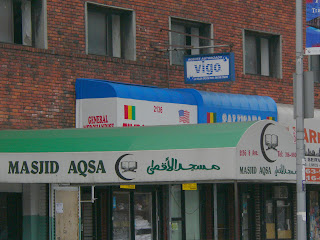The vast majority (>450 of the stops) were visited during a single two week period from July 16-27, 2007. I typically rode the train from 7:30 am to 7:30 pm, sweating it out on platforms from Van Cortlandt Park to Far Rockaway. The last few stops were done on random days thereafter where I could find a little time.
In general, I designed my days such that I could complete about 50 stops in a discrete geographical area of New York. I did not go to every stop in order, but instead bounced around in the most efficient manner. For actual logistics, I pretty much always just rode to a stop, exited the station, walked around, took some notes and photos, and then got back on the train to ride to the next stop.
Motivations: My original motivation was to photograph the inside and outside of every stop, but after a run-in with the police (you can read more about that here) I started photographing where I thought it seemed I wouldn't get arrested/harrassed and otherwise just took detailed notes on my observations. In general, this eliminated the inside of subway stations and still made me nervous enough to avoid taking photographs in many neighborhoods where it’s abnormal to see someone walking around with a camera.
Undertaking this project was not inspired by any great epiphany, political manifesto, or artistic sensibility. Basically, I really love the subway, I love learning about New York, I had two weeks off from grad school, I didn't have any money to travel, and it seemed like a cool idea. I haven't had time since then to get everything together (med school got in the way), so that explains the delay in getting this out there.
I will say that I am a strong believer that the subway is a great equalizer in New York. Not only is it usually the fastest way to get around, people from essentially all socioeconomic classes, ethnicities, ages, and places in their lives mix together day in, day out, without the physical barriers imposed by commuting via cars on a freeway. This city is the most diverse in the world and the subway is the great interconnector. I tried to take full advantage of this connectivity by getting a glimpse of the similarities and differences of how people live in these neighborhoods of varying character.
The NYC subway system is also the largest (by far) in the world in terms of number of stops, as well as the only underground system that’s open twenty-four hours a day. This is an awesome achievement, and while there is plenty of room for improvement (noise, dirt, rats, etc.), in terms of sheer utility I still think we have it better than anyone else on the planet.
Disclaimer 1: Every post represents my quick impression of a single point in time in the life of the area immediately surrounding a subway station. I absolutely realize that in almost every neighborhood things quickly change once I would walk two blocks this way or that. I wish I could have done that, but given my tight schedule it just wasn't possible. In addition, my quick impression easily could have been wholly inaccurate. Thus, I apologize in advance for anything I might write that you disagree with. So please feel free to leave any comments about cool things by your stop (or other ones you know) that I might have missed...I'm sure there are thousands, and I would love to know about them!
Disclaimer 2: There are only 464 posts here but 468 stops. When I did the project in 2007, the Cortlandt St. stops on both the 1 and R/W trains were closed for repairs so I didn't visit them. Plus, the Acqueduct Racetrak stop on the A is only open on race days, which didn't coincide with my schedule. So that gets me up to 467. In all likelihood, the MTA is counting some part of a station as a different stop that I just didn’t set up a separate post for. Let me know if you figure it out.


















































